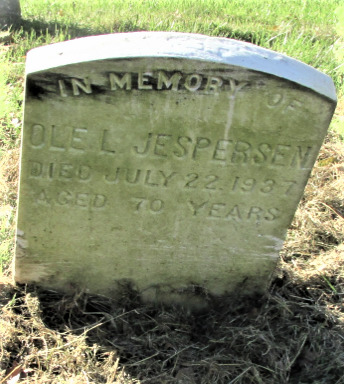Title: Marine Corps Staff Sergeant, Spanish American War, World War I
Birthdate: December 26, 1867
Death Date: July 22, 1937
Plot Location: Naval 4, Row 1, Grave 16

Denmark was Ole’s home and Danish was his language until he came to New York City in 1889 at age 21. He remained single the rest of his life but had a singular and lifelong devotion to his adopted country.
Ole became a naturalized citizen in 1894 and was a waiter when he signed up for the Army on October 26, 1898. He was in Troop F of the 3rd Cavalry but probably never got a chance to ride a horse, since the war with Spain officially ended in December. Ole was discharged by the end of February, 1899, but military life appealed to him, so he reenlisted ten days later, this time for a three-year hitch.
When the two countries signed the Treaty of Paris, it ended the issue of Cuba’s independence but created another issue. Spain gave up the Philippine Islands to the United States in exchange for twenty million dollars. Philippine revolutionaries had wanted independence from Spain, but resisted American sovereignty as well. On June 2, 1899, the First Philippine Republic officially declared war against the United States, which concluded with an American victory in 1902. (The United States eventually granted full Philippine independence in 1946.)
Ole was listed in the Philippines when the 1900 census was taken. Shortly after his discharge in 1902 he signed on with the Marines and stayed with them until he retired. He was assigned to the USS Newark, a ship he might have seen when he was in the Philippines.
During his next tour Ole joined the second ship to be named the USS Maine, shown here. It was built after the first one sank in 1898, precipitating the war with Spain. The Maine was part of the “Great White Fleet,” a group of battleships whose hulls were painted white, as shown here. They were sent on a tour around the world in 1908 to show off American naval power. In the 1910 census, Ole was stationed at Guantanamo Bay, Cuba, later moving to Philadelphia. In 1913 he was promoted to corporal and did a tour with a Marine detachment on the USS Utah.
When war was declared in April, 1917, Ole was a sergeant aboard the USS Texas. He went with the 83rd Company, 3rd Battalion, 6th Marine Regiment for training at Quantico, Virginia that August. They shipped out for France in November and engaged in several crucial battles, the most notable being Belleau Wood in June, 1918.
The 5th and 6th Marines dealt with barbed wire, sharpshooters, and heavy machine gun fire. Ole’s battalion sustained nearly 400 casualties in this forest. Eventually it came down to advancing from tree to tree and engaging in hand-to-hand fighting. There were more casualties in one day than any in Marine Corps history up to that time. The Allies and Germans traded control of the forest six times  over the nearly month-long struggle.
over the nearly month-long struggle.
After the war was over, the French government awarded this “Croiz De Guerre” Medal (Cross of War) to thousands of Allied soldiers for acts of heroism. Ole may have received one for individual merit or as part of a unit award to everyone in his regiment.
The 5th and 6th Marines were also selected for special honor by the Corps, entitling them to  wear the French Fourragere, shown here. Every member of those regiments since 1918 have worn the green braided rope over their shoulder on their service and dress blue uniforms.
wear the French Fourragere, shown here. Every member of those regiments since 1918 have worn the green braided rope over their shoulder on their service and dress blue uniforms.
Ole was discharged in April, 1919 but returned in July, the first of what would be three reenlistments. He was stationed at a Marine detachment in Brooklyn following a stint in the Dominican Republic which was under U.S. occupation.
Most of the rest of his service was at the Marine Barracks at the Philadelphia Navy Yard. Ole spent more than two years as the Post Librarian before retiring in May, 1927. Unlike the first time he left his family, this meant leaving a family behind with no place to go. At 59 years old, what would be his future? It probably seemed like he was set adrift.
After two years on his own he came to the Philadelphia Naval Home. It was good for his mental and emotional health but he didn’t go there because of poor physical health. When he died eight years later the attending physician wrote on his death certificate, “Not seen by [a] medical officer prior to death,” implying no health issues. Ole died from coronary thrombosis, a blockage of a blood vessel of the heart. One risk factor is a sedentary lifestyle which, in retrospect, was something that wasn’t familiar to this old Marine.

Support the Friends of Mount Moriah
Help us in our mission to restore and maintain the beautiful Mount Moriah Cemetery by donating to our cause or volunteering at one of our clean-up events.

